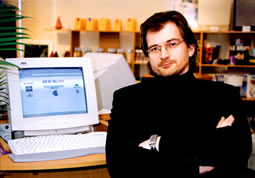History
 |
|
Back in 1984, Stéphane Krsmanovic started
researching states of consciousness at the Free University of Brussels
(ULB) as part of his PhD studies in sports psychology under the
guidance of Professor Van Fraechem-Raway. Originally specialised
in the brain's ability to learn complex movements, Stéphane
Krsmanovic gradually began to shift his focus to techniques to develop
successful performance both in competitive and corporate environments. |
In 1984 and 1985, he studied the effects of sensory isolation
on memory, concentration and learning. He then started investigating the
effects of sensory hyperstimulation (i.e. variable-frequency audiovisual
stimulation). His research revealed remarkable effects on cerebral and
information processing capabilities: enhanced creativity, concentration,
memorisation and comprehension.
In 1996, he completed the experimentation phase of his
PhD with an original experiment conducted in the laboratory of Professor
Sorel, an eminent neurologist from the Catholic University of Leuven.
Professor Sorel had invented the neoencephalograph (Neo-EEG), a technique
that is used to detect brain potential beneath each electrode rather than
the difference in potential between electrodes. It was thanks to this
experiment that Mr Krsmanovic was able to disprove FFA (Frequency Following
Response). The audiovisual stimulation protocols recorded on the microchip
of the Dreamer and Mentalstim (the professional model used by doctors)
are therefore entirely original and based on discoveries made during an
18-year span of research.
Over the years, these protocols were gradually enhanced
with audio software offering suggestions relating to various themes. The
psycho-acoustic technologies developed by PSiO Technologies.com's team
of doctors and professors (experts in the fields of psychosomatics and
superlearning) became also more fine-tuned. Today, these technologies
are the reference both in Europe and abroad.
Current research is focussed on developing new and even
more powerful programmes. |